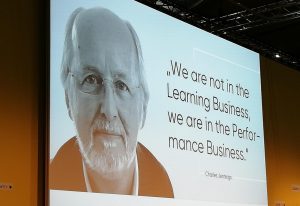First published on TrainingZone.
Having worked in Learning and Development for the better part of a decade, I had to learn how to deal with one fact over and over again: training is often put at the back end of budget requests because it usually takes a long time to measure the impact it has.
Learning is one of the most essential parts of business success
However, offering opportunities for people to grow and develop themselves is one of the biggest factors in their job satisfaction. According to a survey done by Josh Bersin in partnership with LinkedIn last year, “We all know that learning is one of the most essential parts of business success, and it occurs at an individual, team, and organizational level all the time.” In the survey, professionals were asked about where they spend their time at work and what drives their satisfaction levels. “Employees who spend a lot of time on the job learning are measurably more engaged, productive, and successful than their peers.”, Bersin says. The survey results show that people who spend more time learning on the job are for example:
- 74% more likely to know where they want to go in their careers.

- 48% more likely to find purpose in their work.
- 47% less likely to be stressed.
- 39% more likely to feel productive and successful.
Highly-engaged companies spend more on learning
The Udemy ‘State of the ROI of Learning Report’ from 2018 also says that “Highly-engaged companies spend more on learning”, and that businesses can increase their retention rates by also offering more autonomy, career and growth opportunities. Now link that back to the 74% of ‘heavy learners’ from Josh Bersin’s survey who are more likely to know what they want from their career, and you have the start of a pretty good recipe for employee engagement and experience; and an argument to spend more energy embedding learning into work, rather than inventing complicated methods of measuring learning transfer after your employees have completed a series of workshops or ‘click-next’ e-learning modules.
Collaboration encourages workflow learning
Today, we are in constant need of information in real time to help us complete our tasks, but are often made to wait for specific training to happen. A much better way to get the information we need is to know where to find it or who we can ask to get an answer. So, a collaborative approach like peer-to-peer, or social, learning is a great way for your people to teach each other, and on the spot. It additionally provides them with more autonomy at work, which, according to CIPHR “May also be the most important factor when nurturing a culture of engagement within a company.” Engaged employees are more productive and miss less days at work.
When you encourage collaborative learning on the job, you also need to encourage your people to welcome immediate feedback. This really helps them to retain the information better, improve performances and boost skill growth.
Autonomy is key
Your company is a gold mine and information is your currency. Information is free to share using a collaborative learning approach, and to implement this you need to make learning a habit by providing opportunities and tools for your employees to exchange their knowledge with each other. Using a collaborative approach like this, team work essentially, your people will be more engaged in and take responsibility of their learning and also, as mentioned, remember more of the information that they discussed with their colleagues. Just think back to your time at school and how you learned or remembered more stuff during group projects, discussing and explaining different topics.
As you can see, there are so many advantages of integrating learning into everyone’s daily tasks. Letting your employees decide when, how and where they learn will provide them and your company with a greater job satisfaction, engagement, performance and productivity. To name just a few.
Your employees will need very clear goals for them to achieve. Together with the opportunities and support you can provide them with to learn, and work, more collaboratively with their colleagues, they are well on their way to deliver the results your company needs to reach its goals. That’s another benefit.
The performance business
There is still room for traditional training such as workshops or e-learning, but in line with the 70-20-10 model, that should only take up about 10% of the learning your company offers. Charles Jennings, Co-founder of the methodology, emphasises that Learning and Development professionals are in the performance, not the learning, business.
So, if you want your employees, and in turn your company, to perform better, give them the opportunity to learn, anytime and anywhere!
And maybe we don’t actually need to measure the learning outcomes directly, but more the end-results. If everyone hits their goals and does a good job, how much does it matter how they got there? Just trust them and let them get on with it, they are after all adults capable of making their own decisions.
What do you think? Does collaboration encourage workflow learning? Leave a comment below.

